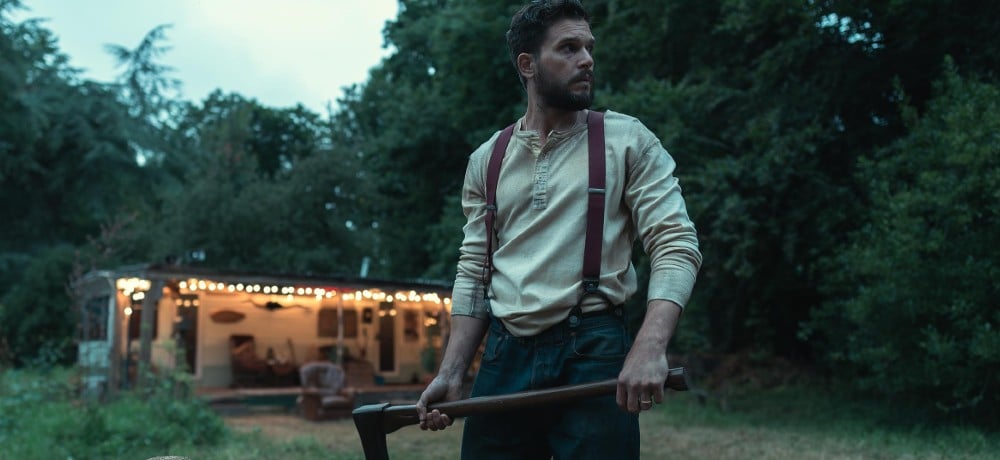


One of my favorite films from Fantasia this year is a monster movie that asks its characters to understand what a true monster is. From writer/director Alexander J. Farrell and co-writer Greer Ellison, The Beast Within is a smart and understated yarn about a young girl struggling to understand the cycle of abuse that has become a staple of her family dynamic, and the mysterious creature that her father turns into every full moon.
In The Best Within, a family lives isolated in rural England. They reside in a small farmhouse, walled in and protected by a strong gate. Ten-year-old Willow (Caoillinn Springall) is becoming old enough to start to understand the world around her, and is realizing that her family is keeping secrets from her. Periodically, her father Noah (Kit Harington) disappears. He leaves before nightfall, returning the next day, weak and bloody, being dragged into the house by her mother Imogen (Ashleigh Cummings) and her grandfather (James Cosmo).
“Why does he always come home like this?” Willow asks Imogen one night. Her mother doesn’t have a good answer.
One night, Willow follows her parents into the woods, and learns the truth about her father. For a few nights every month, he goes to a nearby ruin and Imogen locks him in a cell. By the light of a full moon, he changes into something monstrous. Something animal. Her father is gone and in his place is something bloodthirsty and violent.
The Best Within is about a young girl coming to understand the truth about her father, and coming to terms with the fact that her childlike understanding of the world is not how the world actually is. When she first sees Noah transform, she is terrified. Imogen runs in to protect her, and to try to make her feel safe. But there is only so much comfort that can be given in the face of trauma.
As the dynamic between the family members intensifies, Noah tries to explain to Willow the truth of what he is. He said that his grandfather was similarly afflicted, and he ran deep into the woods every full moon to hide it from everyone he knew. Noah couldn’t bear to do that; to live in secrecy. So he inflicted it upon his family. He has Imogen there with him every time, locking him up, and coming to free him in the morning. She is there to deal with his mood swings, his violent outbursts and his abuse. And as time has gone on, Willow has seen all of this. She sees the truth, has learned these patterns, and has incorporated them into everyday life. As frightening as it is, this has become normal to her. This is how cycles are created.
The story unfolds from Willow’s perspective. The audience is largely subject to only things she sees and hears. We are witnessing the cycle of abuse from a child’s perspective, as she tries to piece together the things she is seeing and reconcile them with the family life that she knows. We see change take place in the other characters (Imogen has moments of standing up to protect herself or her daughter, Noah has moments where he understands the nature of his behavior and tries to smooth it over), but the biggest character moments are with Willow. In a lot of ways, this is a coming of age film. Willow has to understand the true nature of her family and has to make choices about how she is going to handle it. In the finale, we see her take on a very adult role, as many children in abusive situations must.
The cast is amazing. Springall (who we saw earlier this year in Stopmotion), really brings the complexities of Willow’s character to life. The reactions that she has to the events surrounding her and the way she processes them feel very real, and she brilliantly communicates Willow’s state of mind to the audience. Cummings and Harington complete this triangle skillfully, each bringing their characters to the screen in a way that feels real and never rings false. Harington, in particular, gives a strong performance. We don’t simply bounce back and forth between Nice Dad and Monster Dad. During those softer moments where he does legitimately seem to have the monster under control, there is something…there. Something rigid. He doesn’t fully allow himself to relax into the role. Instead, he keeps something of that monster just below the surface, always lurking.
The werewolf effects are solid, but minimal. Toward the end, we get to see Harington go full werewolf with some good practical effects from Rob Rowley, but Farrell wisely chooses to shoot it in close-ups and shadows. We get enough to get the gist of it, and then our imaginations get to do the rest. Because at the end of the day, the monster was with us all along. We didn’t need to wait for the full moon.
The way this film handles cycles of abuse and violence is unique in that Farrell doesn’t seem interested in burying it under layers of subtext. It’s text. It’s there for us to pick up as soon as the film starts. And in this story, that approach works really well. We see how Willow deals with these complicated situations as she begins to understand the true nature of the people who are supposed to love her and keep her safe. As she comes to learn, some beasts can’t be soothed, but some cycles can be broken.
Movie Score: 4/5